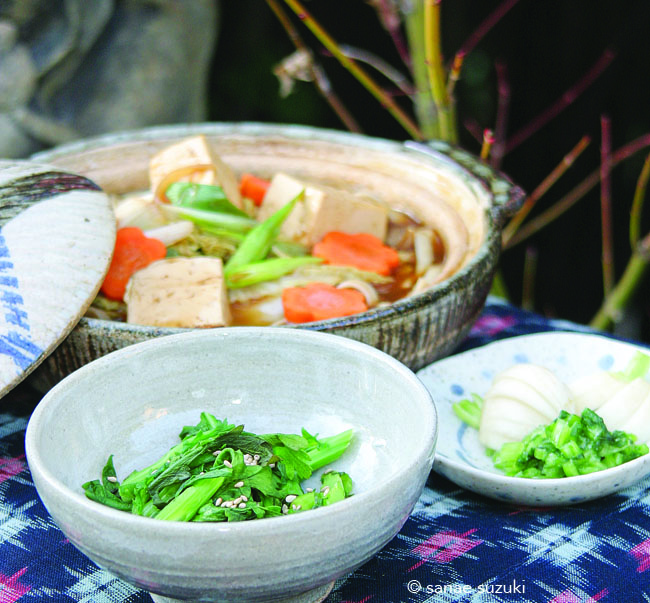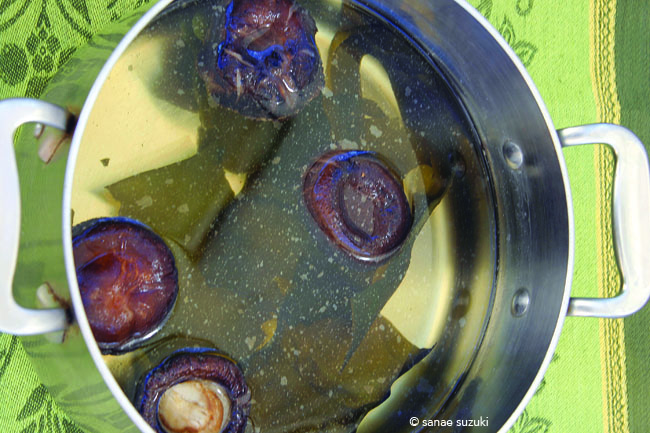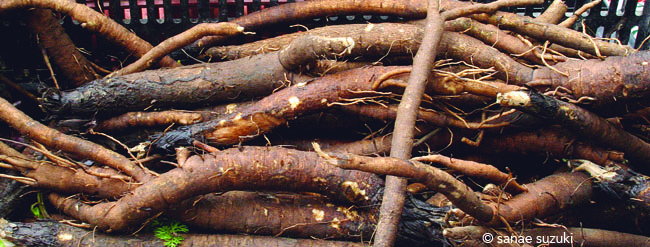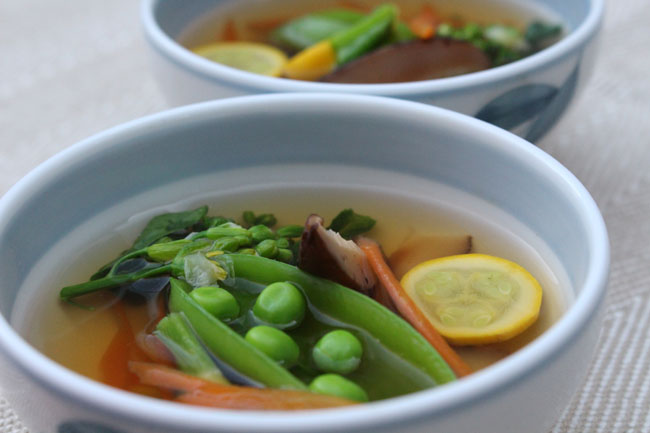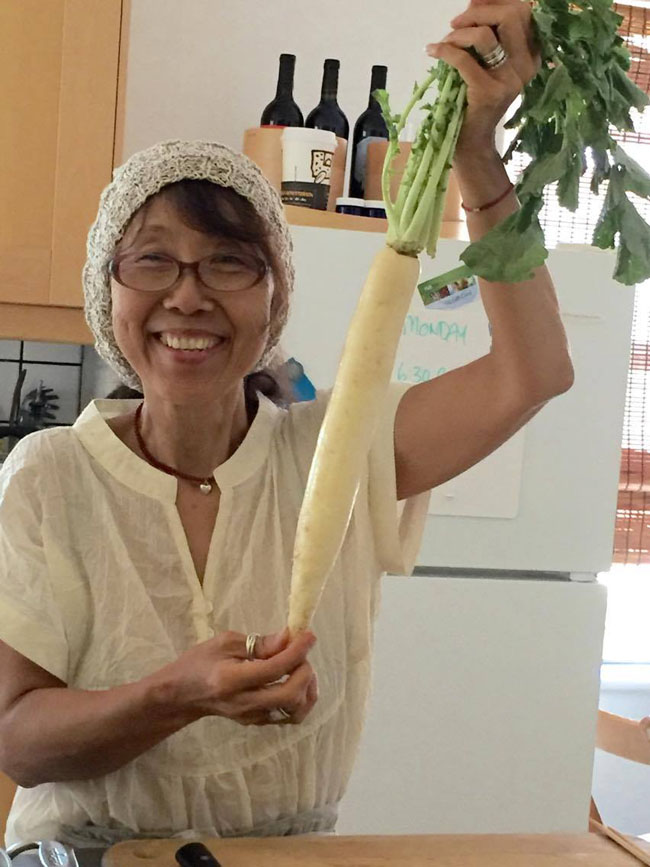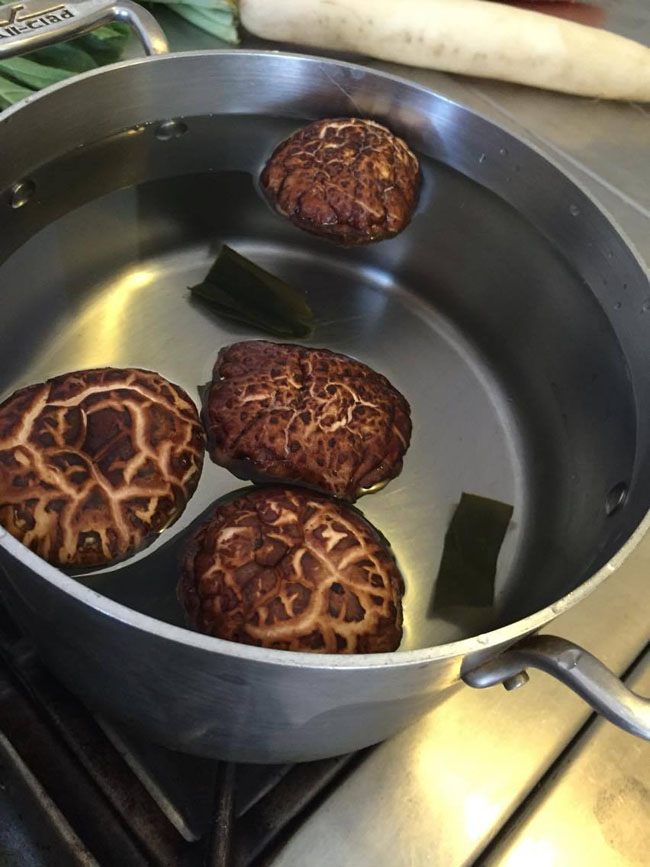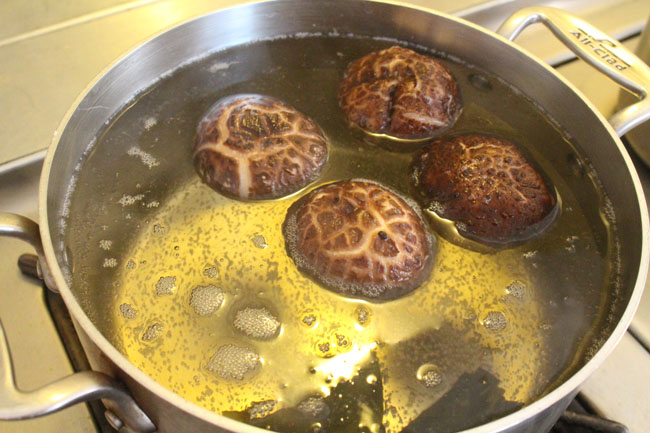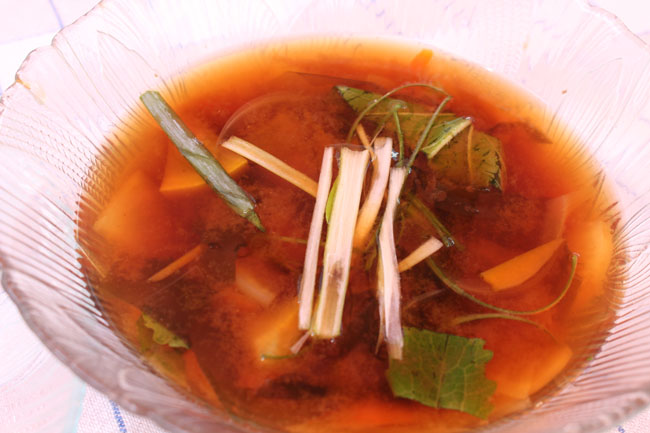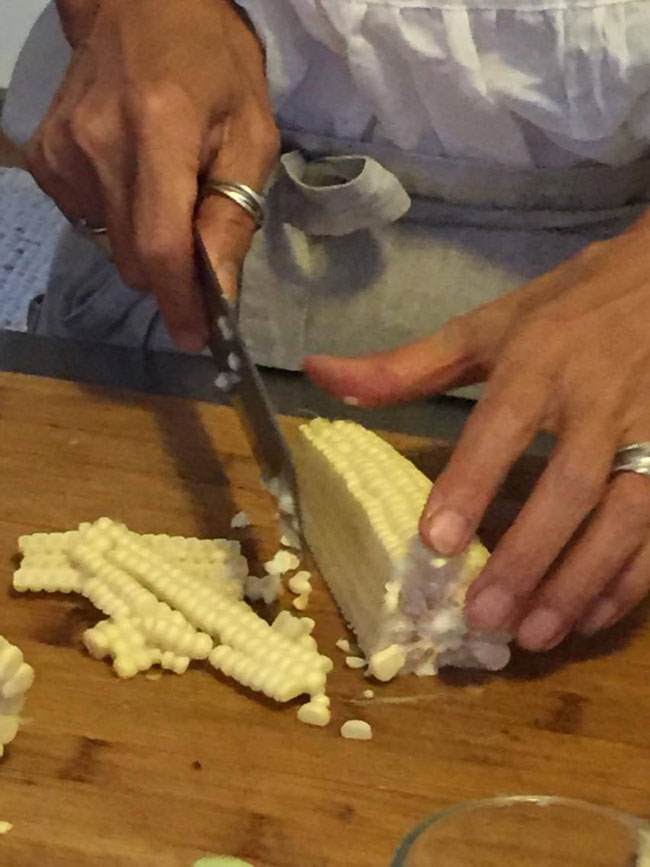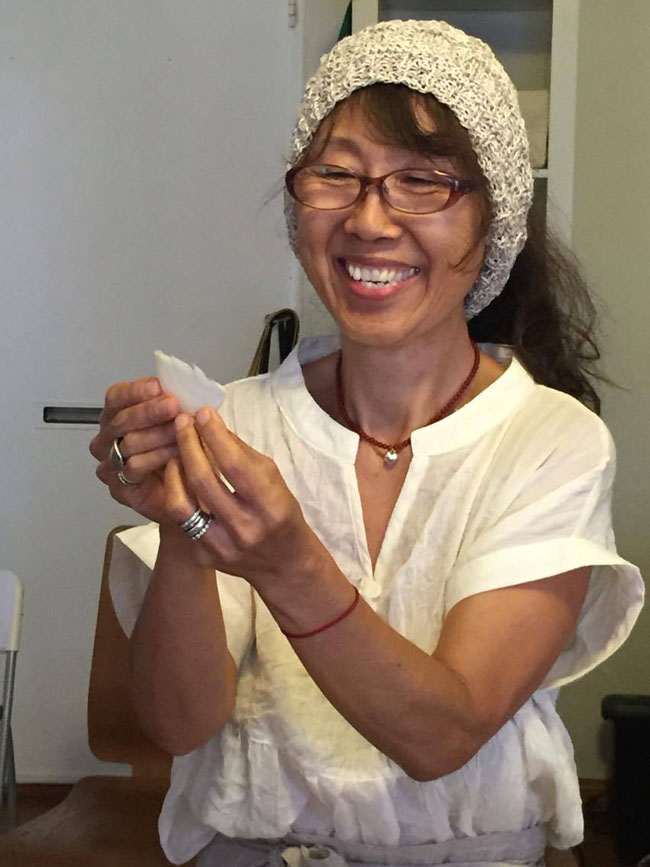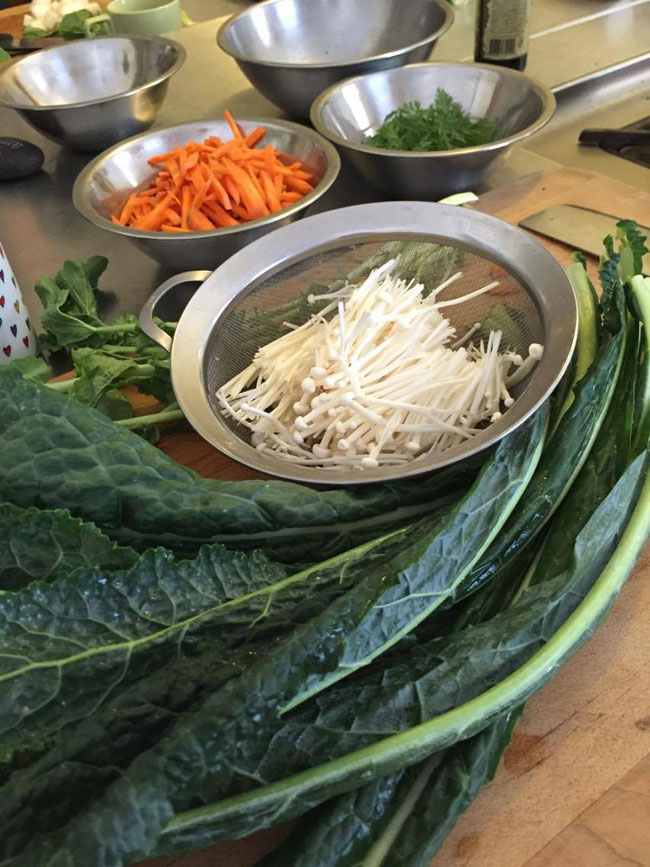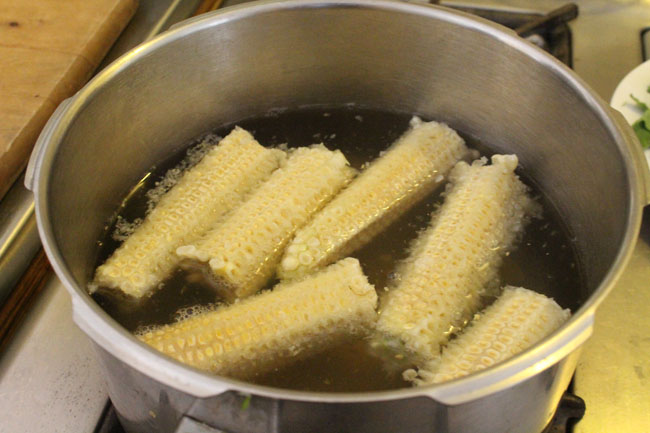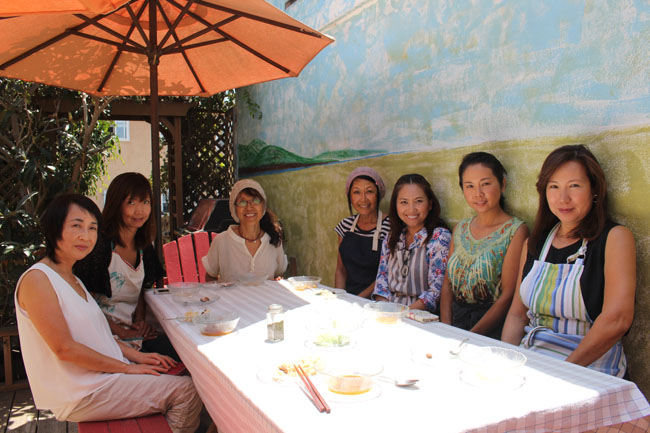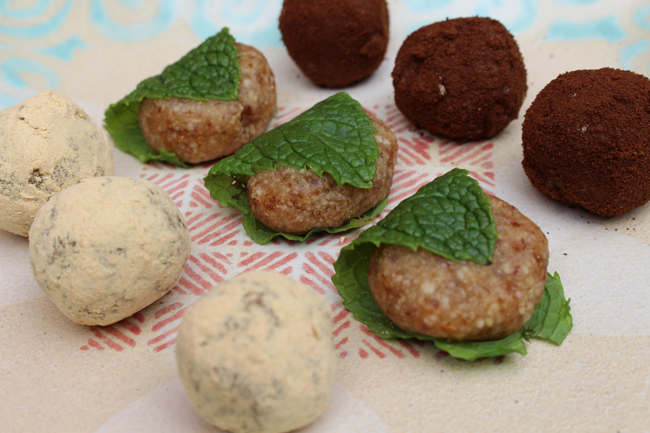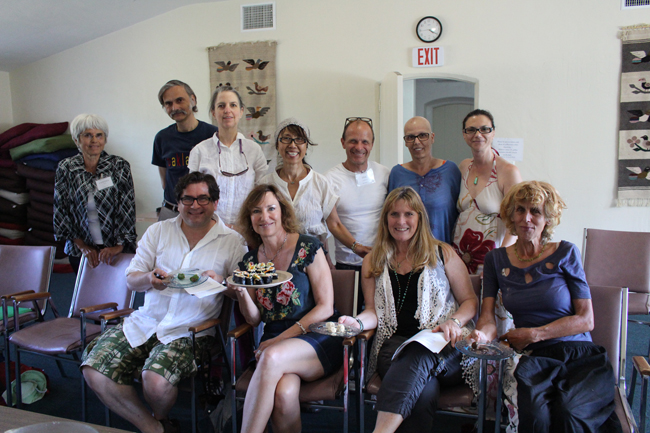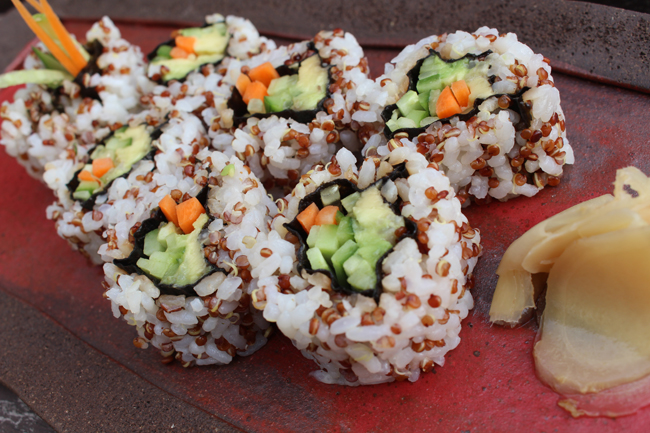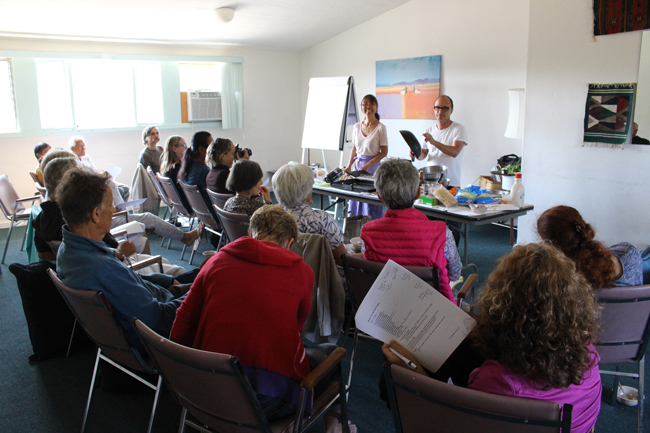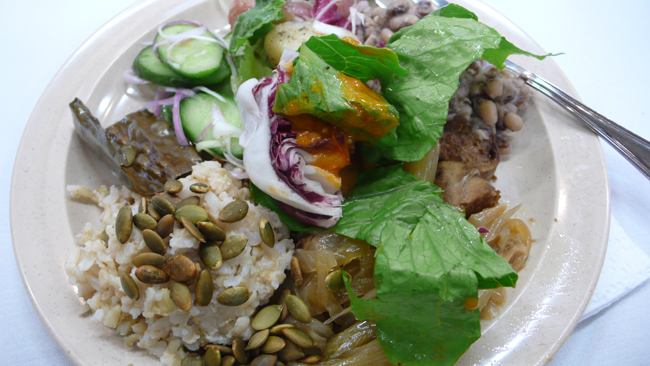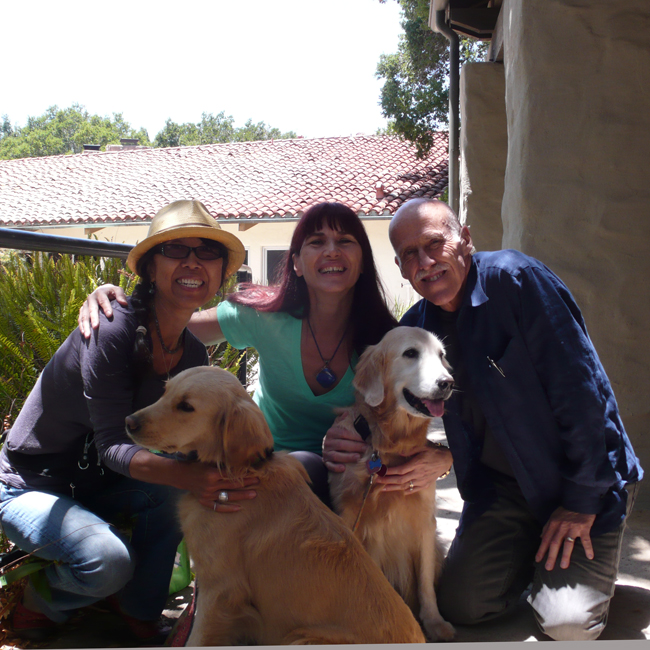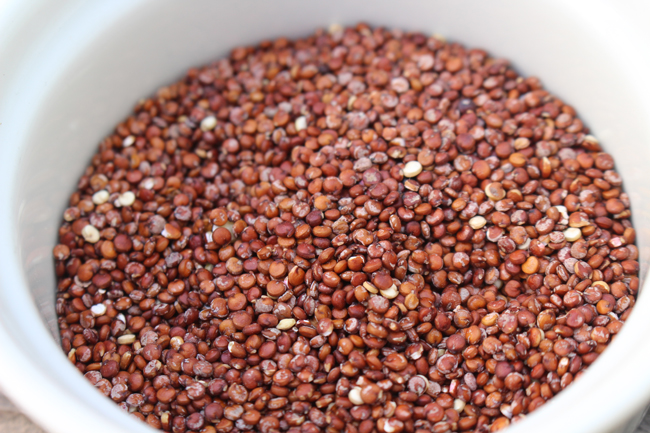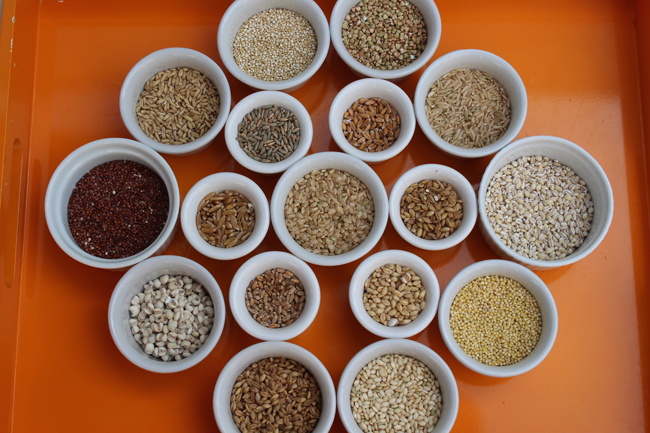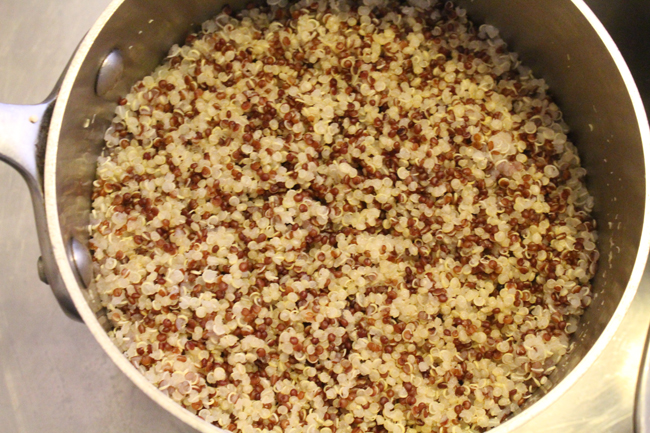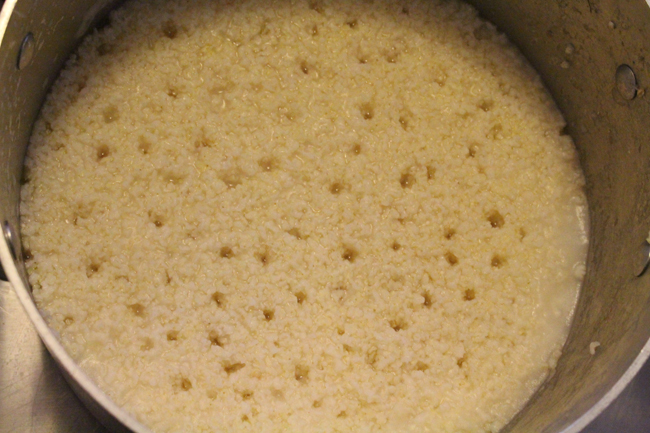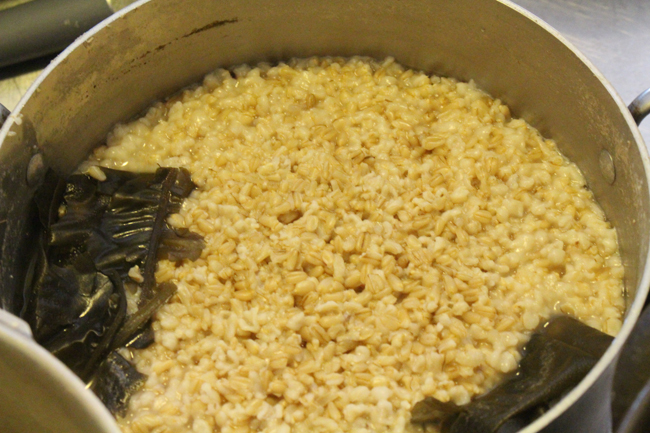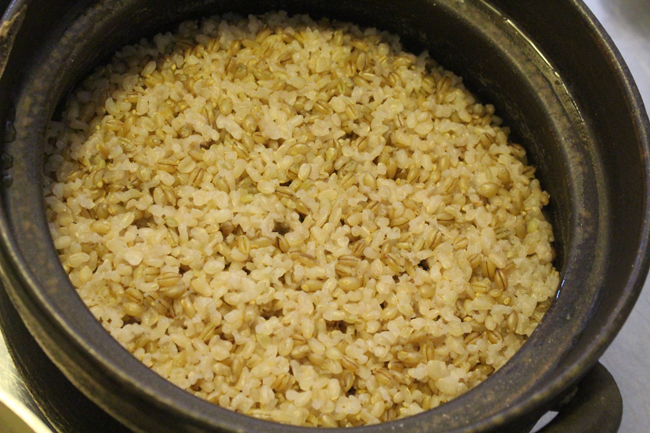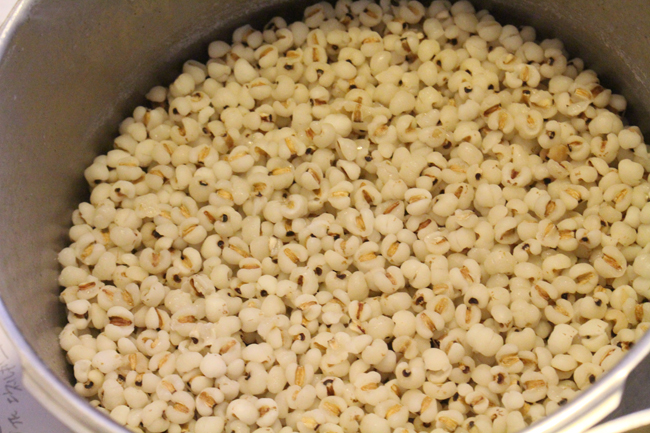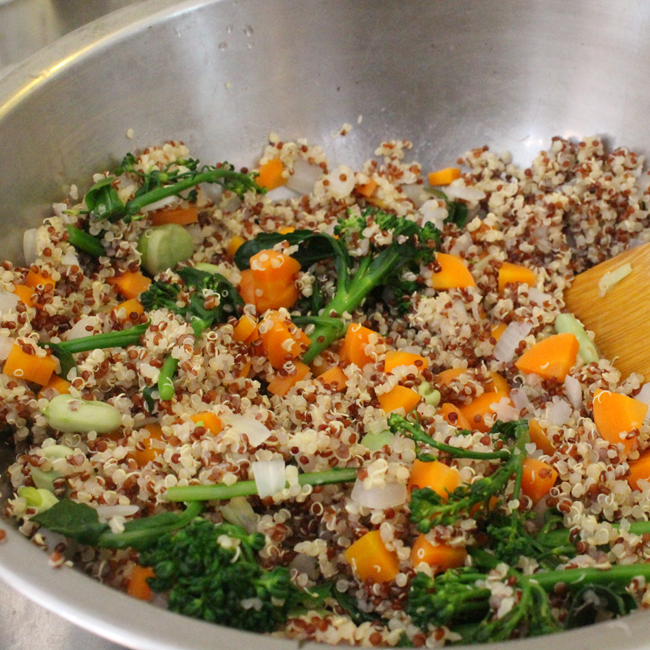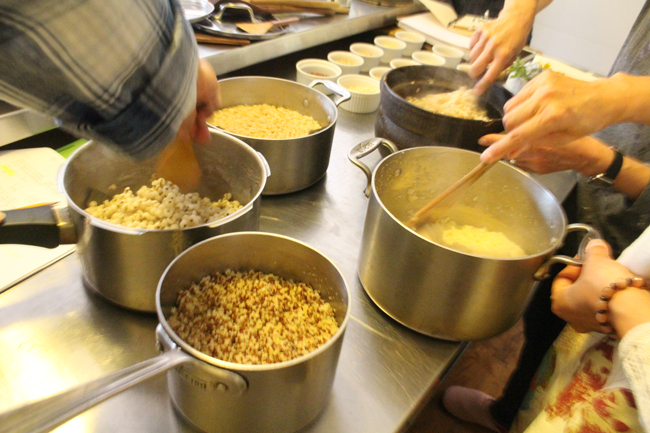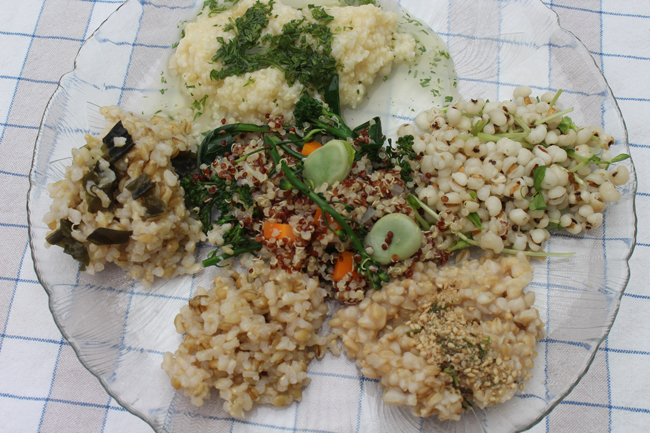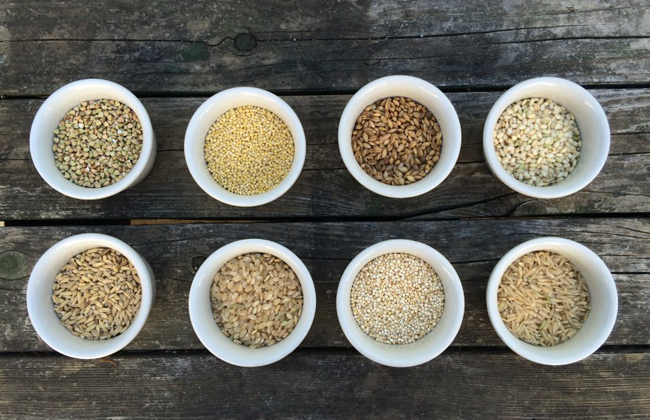
Since I am from Japan it is a joy when I get to teach class in my native language, which is not often here in the United States.
When January 2016 arrived one I made one of my New Year resolutions to teach my macrobiotic principle cooking class series in Japanese once again. The last time I offered this series in Japanese was three years ago. After that I only taught a single Japanese class here and there, so this time I committed to teach one every month. Students will benefit by learning macrobiotic cooking from a more complete, progressive program of courses. I am grateful that I have realized my goal and started the first class last week.
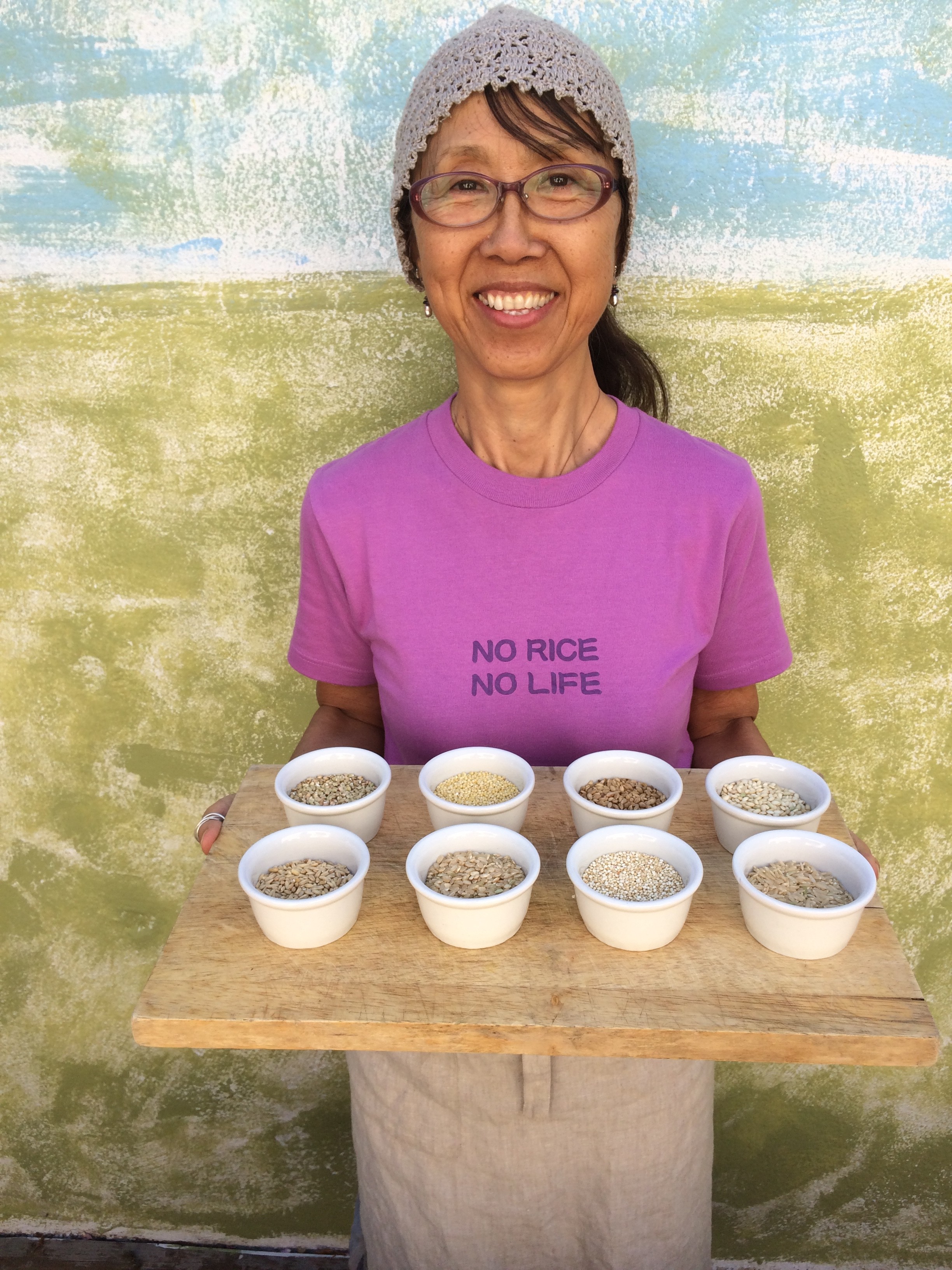
“No Rice No Life” T-shit was a perfect for this class. Can you identify these whole grains?
I taught Whole Grain part 1 cooking class last week. Introduced eight different whole grains: 1) short grain brown rice, 2) long grain brown rice, 3) sweet brown rice, 4) whole oats, 5) whole barley, 6) millet, 7) quinoa, and 8) buckwheat first (this was fun for students to know there are many whole grains and to identify whole grains since most of us do not know many whole grains are available for us to cook. I showed how to prepare and cook brown rice the traditional way (macrobiotic way), without a rice cooker. All the Japanese students know how to make white rice in the rice cooker and some know how to make brown rice, since rice cooker companies have developed the rice cooker for cooking brown rice. Japanese people usually never make rice without a rice cooker, and I was one of them until 1993. It means departing from a convenient routine, which is not easy for most of us. Japanese students are very polite, and they do not say much in class; I guess they do not want to interrupt the teacher, but after class some of them ask me questions or tell me their thoughts. During this class only one student who had lived in the U.S. for a long time spoke up. Most of them told me after class that they were a little concerned that brown rice would not be as tasty if they did not use a rice cooker, but they were surprised when all the three different kinds of preparation of brown rice came out so delicious, even better than when cooked in a rice cooker. In fact, they found the rice that got burned at the bottom to be tasty as well. That’s right, after having taught cooking for over 20 years, I still burn the rice, and I want my students to see me as I am – not perfect. I want them to understand that sometimes we burn the rice, and it is alright as long as we know why it happened. It is important to accept it, since making mistakes is part of life, right? We just need to know what happened and do our best to not repeat the mistake as much as we can (but we also accept that as humans we make the same mistakes over and over until we really learn).
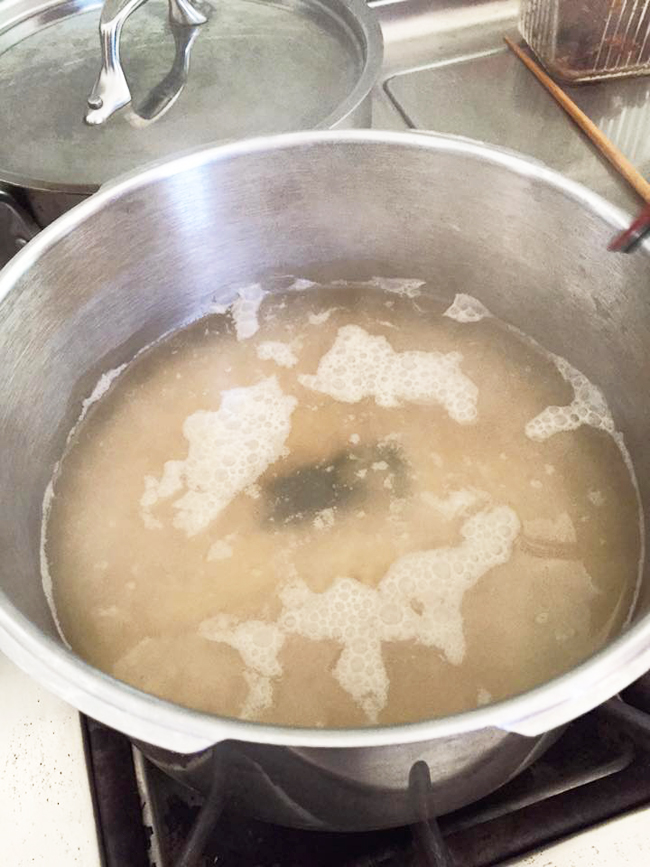
Brown rice with kombu sea vegetable
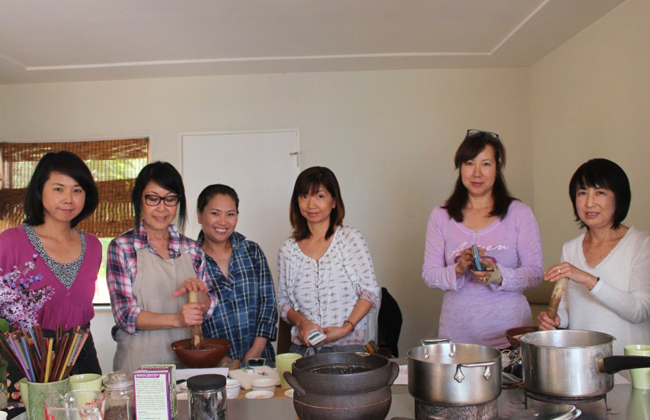
In this class I showed three different ways to cook brown rice:
First, all the brown rice are washed and soaked over night.
1. in a stainless steel pot, 2 cups of brown rice with 4 cups water and add a pinch of sea salt when it start to boil and simmer for 45 minutes. You don’t have to mention how much rice & water to add?
2. in a ceramic pot, called “Nabe” in Japanese, 2 cups of brown rice with 4 cups water and add a stamp sized piece of kombu sea vegetable when it start boil and simmer for 45 minutes.
3. in a pressure cooker, 2 cups of brown rice with 4 cups water add a umeboshi plum (Japanese traditional pickled ume plum, which is very high in alkaline (organic California aged umeboshi plums can be purchase at Seed Kitchen) when it start to boil and simmer for 45 minutes.
Since I had not used the pressure cooker for a while, the pressure did not go up correctly, and I was also talking to students when it was time to remove it from the stove, so the rice cooked too long, burned the bottom slightly. I quickly removed it from the stove when I realized that I was talking instead of watching the pot, so I kindly sent the good wish to the rice and said “Sorry to have missed your perfect timing, but I am sure you are going to be tasty!”
I added quickly blanched stems of kale to the burned rice to dress it up with green polka dots, so it looked and tasted better.
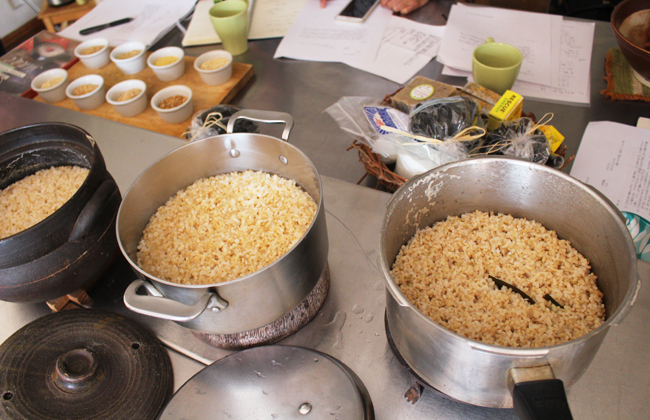
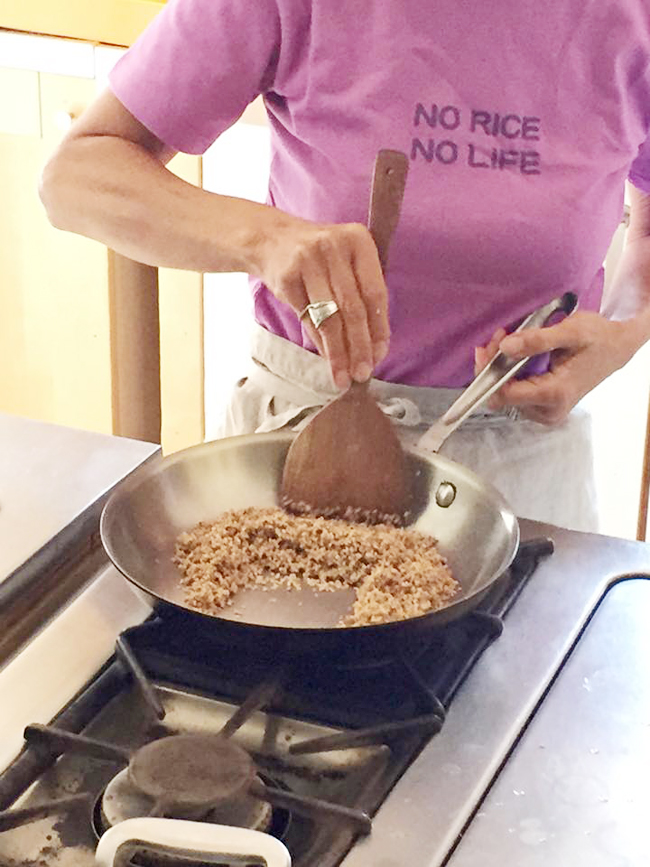
Roasting sesame seed after you rinsed sesame seed with water.
I also taught how to make gomashio (sesame salt which is usually recommended to eat with grains) condiment and quick water sautéed onion, carrot and kale.
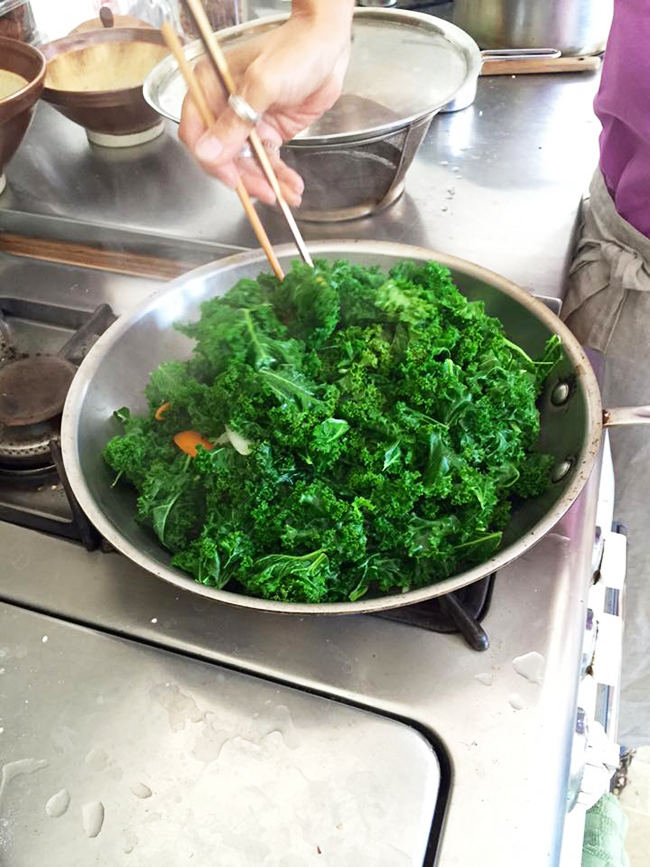
Water sautéed kale.
There was no time to teach how to make the dressing so I served fresh tahini miso dressing from Seed Kitchen (my husband Eric Lechasseur and my restaurant in Venice, California) which was so tasty some of the students were pouring it over the brown rice. Everyone wanted to learn how to make this dressing in the next class.
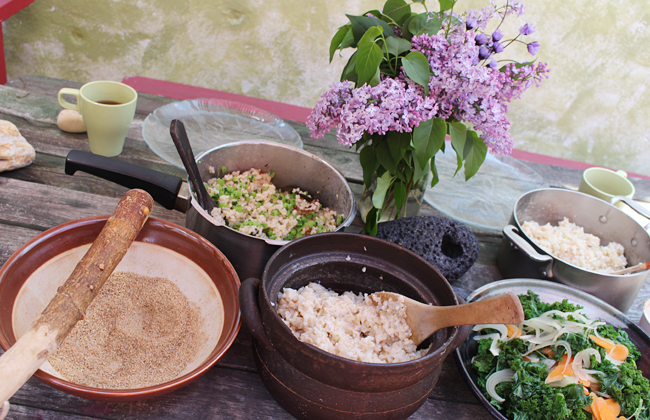
The food was all ready!
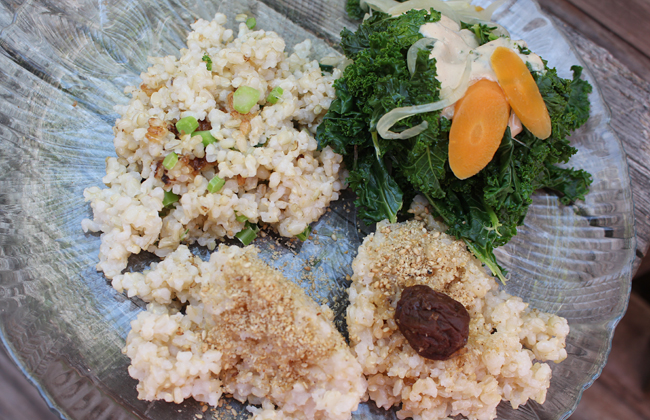
Simple and beautiful delicious three different kinds brown rice with vegetables.
We had a delicious lunch together outside on the picnic table under the California sunshine.
We all look forward to meeting again at the next class, Whole Grains part 2.
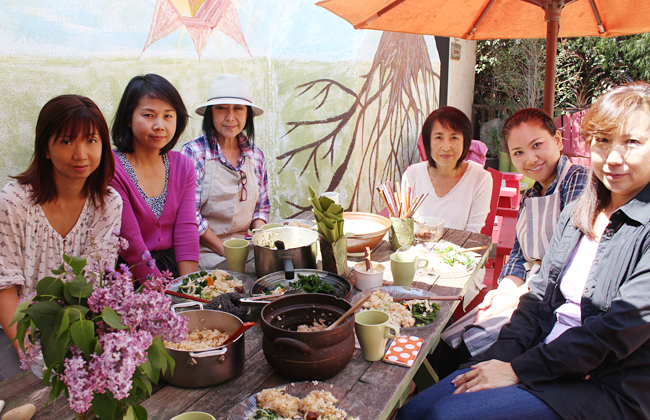
Love, Sanae❤️
These below questions are from one of students who took the class. I want to share them for other Japanese students to see and learn from them.
ビーガン・マクロビオティック基礎シリーズクラス第1回:
炊飯器を使わないで伝統的な玄米炊き方3種類。
下記にあるのはこのクラスを受講したYukoさんから来たメールにある質問ですが、
Yukoさんから承諾をもらってこのブログに載せました。
この答えがみなさんのお役に立てたら幸いです。
ー草千先生、
一昨日のクラス、ご指導頂きまして有難うございました。
素晴らしいメンバーの方々にも会えて感謝の気持ちでいっぱいです。
クラスの後にSeedに寄って主人と美味しいクッキーと昆布とお塩も購入させていただきました。
購入したお塩ですがお塩は常温保管でよろしいですよね?
入れ物(瀬戸物、ガラス、または木で作られた)に入れて常温で保存して下さい。
さて、課題の玄米炊きのおさらいとして早速、昨日ステンレスのお鍋で玄米を炊いてみました。
炊き上がり、表面は”カニの穴”も出来てふわっと炊けましたが鍋底は真っ黒に焦げてしまいました(涙)。。。
やはりフレイムディフレクターが無いせいでしょうか?
又は火が弱火よりちょっと強かったのかもしれません。
フレイムディフレクターがあれば焦げなかったでしょうが、きっと火の加減も少し強かったのかもしれませんから、次回は気をつけてみてやって下さい。
そして、ごま塩もホールフーズでオーガニックの生のゴマを見つけたので早速作りました。
やはりホカホカのご飯に香ばしいごま塩は最高ですね!レシピのとおりごま大さじ12に対しお塩を小さじ2杯で作ったのですが教室で試した時よりも塩辛い感じがしました。
お教室の時は少なめでしたか?
レシピは、スタンダードなごま塩の作り方の量になっていますが、クラスでは、感覚的に少し塩を少なめに使いました。
レシピは参考に使って自分の感覚や体調によって変えていくことが大切です。
お塩を煎ってすり鉢にかけてごまを煎ってすり鉢にかけてじーっくりと美味しくなるようにごま塩を擦っている時は私にとって良いメディテーションだなぁと思いました(笑)。
そうですね、メディテーションと言って正解ですね。私もごま塩を作る時にいつもそう感じていますよ。
この次は圧力鍋と土鍋で試してみます。尚、お鍋ですが
オススメの圧力鍋のメーカーなどございますか?
圧力鍋はいろんな種類があって好みだと思いますが、私は、KUHN RIKONを使っています。
土鍋は先生のような深いご飯炊き用が良いのですよね?
鍋は通常の鍋でも美味しく炊けますので、もしもっていたらそれをまず使ってみて下さい。
私が使っているご飯炊き用の鍋を見つけたら購入してみて下さい。
いくつかの質問、アドバイスいただけたら幸いです。
よろしくお願いいたします。
P.S. マクロビにコーヒーは厳禁だと思います。がどうしても朝のコーヒーがやめられません。
先生の本に色々なレメディドリンクのレシピがありますが
私におすすめのドリンクはありますか?
マクロビをしている人でコーヒーを飲んでいる人もいますが、
お茶やコーヒーに含まれるカフェインは、カルシウムの排出を進ませますので、
やはり病気治しをする時はコーヒー、お茶を飲むのをやめるべきだと私は思います。
やめる為のレメディーは、実際にはありませんが、甘い野菜のレメディーは、コーヒーを飲んで疲れ気味な膵臓を癒してくれます。(Love, Sanaeの本のページ164のSweet vegetable Drink参照)
やめ方は少しずつ飲むのをやめる方法と一度の飲むのをやめる方法のふたつですが、どちらにするかは自分の性格とやめた時の精神的また感情的状態を把握して心の準備が必要です。
少しずつやめる場合はコーヒーをお茶(緑茶)に変えてから少しづつ減らしていくと成功率が高いと他の生徒さんやクライエントさんから聞きました。
コーヒーを飲むのをやめた時どんな禁断症状があるか、それとコーヒーを飲むのをやめるときに注意することを次回のクラスで少しお話しますね。
愛をこめて、草千❤️
